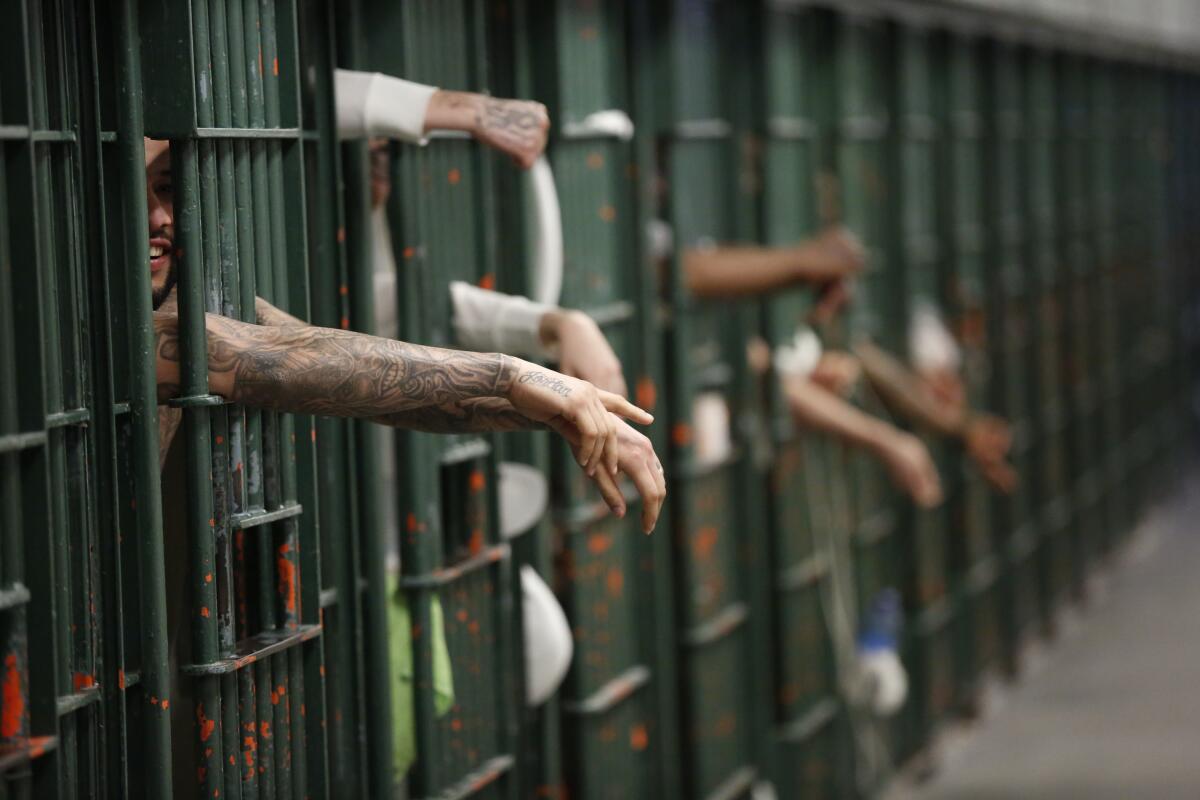Three inmates died in Los Angeles County jails in just over a week

- Share via
Three Los Angeles County inmates died in an nine-day period this month, according to the Los Angeles County Sheriff’s Department, a grim milestone that comes even as the county is facing scrutiny in court for using a cash bail system that can keep poor people behind bars.
The youngest of the men who died in March — 29-year-old Samuel Mark — was being held on misdemeanor charges for check fraud and theft, according to court records. He died Thursday morning at Men’s Central Jail, three days after his arrest. Like the others who died this month, he had not yet been sentenced for a crime.
The Sheriff’s Department has not released the names of the other two men who died.
To people paying close attention to the county’s lockups, the cluster of deaths did not come as a surprise.
“Because the jails are operating 20% over capacity, we’re going to continue to see people dying,” said Melissa Camacho, a senior staff attorney with the American Civil Liberties Union of Southern California. “There are just too many people there for correctional health services to provide adequate medical care and treatment.”
When asked Monday about the recent deaths and whether overcrowding played a role, the Sheriff’s Department said in a statement that “various factors contribute to the loss of life.”
“We are saddened by any loss of life,” the statement said. “We take our responsibility of providing a constitutional level of care for those in our custody seriously.”
Los Angeles jails are on track to see fewer deaths this year than last, though incomplete information makes it difficult to draw conclusions about why. Seven people have died behind bars this year; records show the jails had seen 11 deaths by this point last year.
But the cause of death has not been officially determined for the majority of this year’s fatalities, and medical examiner records show autopsies are not finished in roughly a third of the 44 cases from 2022.
Nicholas Shapiro, an assistant UCLA professor who serves as director of the Carceral Ecologies Lab, said he did not see “any cause for celebration” despite the slower pace of deaths in 2023.
“The jails are still over capacity, and over half the deaths this year are of Black men in a county where something like 5% of the population are Black men,” he said. “When incarceration rates are vastly reduced and the county meets its goals to close Men’s Central Jail, I’ll definitely be singing from the rooftops.”
Three years ago, county supervisors voted to create a plan for shuttering the decrepit jail, though the county has since come under fire for its apparent lack of progress toward closure.
The recent string of deaths comes amid a days-long hearing in a lawsuit that could rein in the growing jail population by forcing the county to revamp its use of cash bail.
As of now, when police or deputies in Los Angeles make an arrest, the responding officers figure out bail based on a predetermined schedule that takes into account the type of charge but not the person’s ability to pay.
If the arrestee can’t afford bail or a bail bondsman, they’re held in a substation or sent to the county jail — often to the overcrowded Inmate Reception Center, where people are routinely chained to chairs or gurneys; denied food, water and showers; and made to sleep in cells covered with feces.
They wait there for anywhere between two and five days until they see a judge who can take other factors into consideration and potentially adjust the bail amount. As a result, people who do not have money wait in jail while those who do are able to go free — even if they are facing the same charges and present the same risk to the community.
In November, a group of inmates and religious leaders sued the county, the Sheriff’s Department, the city and the Los Angeles Police Department, arguing that the bail system in Los Angeles County is unconstitutional.
“On any given night, people languish in jail cells throughout Los Angeles County because they lack the cash required to purchase their release,” the suit says. “These individuals are not detained on the basis that they are too dangerous to release: the government would release them right away if they could pay. Rather, they are too poor.”
Proponents of cash bail say it helps make sure people show up to court, and lawyers for the county responded to the suit by accusing the inmates’ attorneys of disregarding “victim and public safety issues entirely.” In the same filing, they wrote that the county agrees that “‘wealth-based detention’ is completely and totally unacceptable.”
But the county shouldn’t have been the target of the lawsuit, they said, because the bail schedules were set by judges whose courts are considered part of the state government, not the county government.
Similarly, lawyers for the city wrote that their police were simply following the law by carrying out the existing bail schedule, and that they needed to do so “lest officers be subject to criminal penalties themselves.”
The two sides began squaring off in court last week. When the hearing concludes, the judge will decide whether to grant the inmates’ request, ordering broad reforms to the bail system and, in the meantime, directing the city and county to go back to the emergency zero-bail schedule that was in place for the first two years of the pandemic.
“Under the emergency bail schedule, individuals arrested for the lowest-level offenses were released without money bail,” said Salil Dudani, a staff attorney with Civil Rights Corps, a nonprofit legal organization representing the inmates who are suing.
“Multiple reports by the county have confirmed that rearrest rates and rates of reappearance in court were stable under the emergency bail schedule,” he added. “And the county itself has repeatedly said that this made a positive difference in the human rights crisis caused by jail overcrowding in Los Angeles jail.”
At least 10 people in recent years have died in jail because they couldn’t afford the bail under the existing schedule, he said.
In addition to the bail litigation in state court, the county is also grappling with a federal lawsuit filed by the U.S. Department of Justice and a pair of class-action cases filed by the ACLU, one of which dates to the 1970s. In that case, ACLU lawyers recently asked a federal judge to find that county in contempt for failing to fix “appalling” conditions in the Inmate Reception Center.
More to Read
Sign up for Essential California
The most important California stories and recommendations in your inbox every morning.
You may occasionally receive promotional content from the Los Angeles Times.











